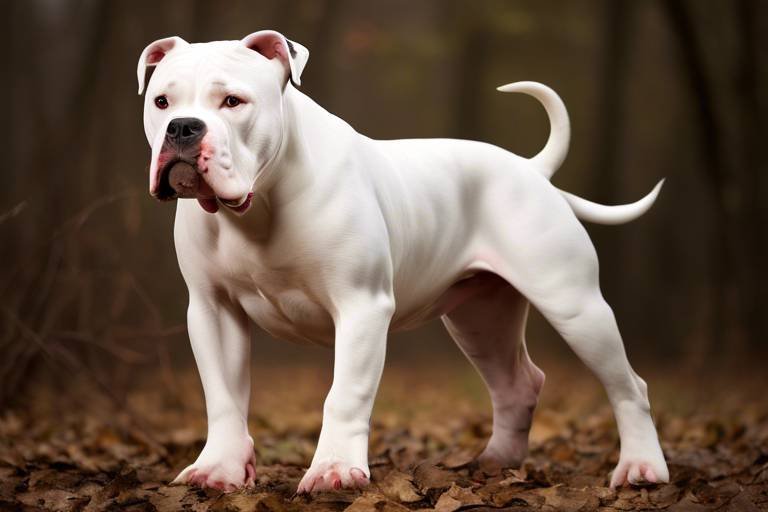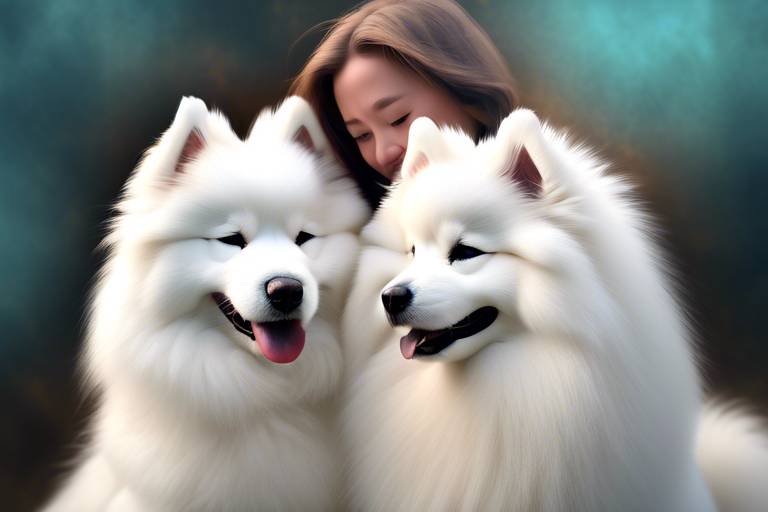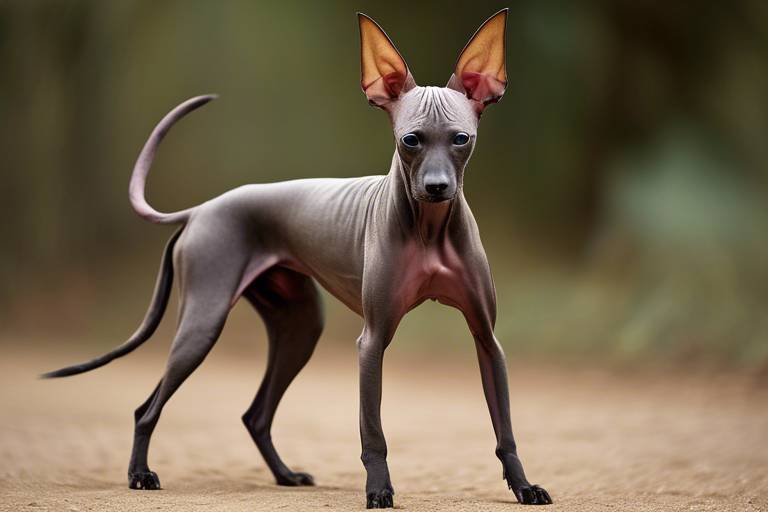How to Identify Dog Breeds by Their Physical Traits
Identifying dog breeds can be a delightful yet challenging task, especially when you're faced with a furry friend whose lineage is a mystery. This article explores various methods to identify dog breeds based on their physical characteristics, including size, coat type, ear shape, and more, helping enthusiasts and pet owners recognize different breeds effectively. Understanding these traits not only enhances your knowledge of dogs but also deepens your bond with them. So, whether you're a seasoned dog owner or just starting your journey into the canine world, let’s dive into the fascinating realm of dog breed identification!
Understanding the size and build of a dog is crucial for breed identification. Different breeds exhibit distinct height and weight ranges that can help narrow down possibilities when assessing a dog's physical traits. For instance, think about the difference between a Great Dane and a Chihuahua. One towers over the other, making size a vital clue. Typically, dog breeds can be categorized into three main size groups:
| Size Group | Height (inches) | Weight (lbs) |
|---|---|---|
| Small | Up to 12 | Up to 20 |
| Medium | 13 - 24 | 21 - 50 |
| Large | 25 and above | 51 and above |
By observing a dog's size and build, you can start to piece together its potential breed background, leading you closer to the answer.
The coat type and color can provide significant clues about a dog's breed. From short-haired to long-haired varieties, and various color patterns, these traits are essential in recognizing specific breeds. For example, a Golden Retriever is easily identifiable by its long, flowing golden coat, while a Dalmatian stands out with its unique black or liver spots on a white background. The texture of the coat can also vary:
- Smooth - like a Beagle
- Wiry - like a Scottish Terrier
- Curly - like a Poodle
Identifying the coat type and color can significantly narrow down your search for a breed.
Ear shape and position are distinctive features that vary among breeds. Observing whether a dog's ears are floppy, erect, or semi-erect can aid in identifying its breed. For instance, a Siberian Husky is known for its erect ears, while a Basset Hound sports long, floppy ears. These ear characteristics not only help in identification but can also give you insights into the dog's personality. Dogs with erect ears are often more alert and curious, while those with floppy ears may have a more laid-back demeanor.
A dog's tail can reveal much about its breed. Tail length, shape, and how a dog carries its tail can be indicative of specific breeds and their characteristics. For example, a Boxer typically has a short, docked tail, while a Afghan Hound flaunts a long, flowing tail. Additionally, the way a dog carries its tail can signal its mood: a wagging tail often indicates happiness, while a tucked tail can suggest fear or submission. Pay attention to these details, as they can be crucial in identifying a breed.
Facial features, including muzzle length, eye shape, and overall head structure, play a significant role in breed identification. For instance, a Pug has a short, flat muzzle, while a Greyhound has a long, narrow head. These facial characteristics can help differentiate between breeds with similar body types. Additionally, the shape and color of a dog’s eyes can also provide hints about its breed. For example, the striking blue eyes of a Husky are iconic, while the deep-set eyes of a Rottweiler give it a distinctive look.
The structure of a dog's legs can provide insights into its breed. Different breeds have unique leg lengths and shapes, influencing their movement and overall appearance. For example, Dachshunds have short legs that reflect their original purpose of burrowing into the ground, while Greyhounds possess long, slender legs designed for speed. Observing how a dog stands and moves can help you identify its breed. Are the legs straight and sturdy, or are they more delicate and elongated? These observations can be key indicators.
A dog’s age can affect its physical traits. Puppies may not exhibit the same characteristics as adults, making it important to consider development stages when identifying breeds. For instance, a puppy may have a fluffier coat or different ear shape that changes as it matures. Understanding these developmental changes can prevent misidentification and help you appreciate the dog's growth journey. So, if you come across a young pup, remember that its adult features might still be in the works!
While not strictly physical, certain behavioral traits can be linked to specific breeds. Observing a dog's temperament and energy level can provide additional context for identification. For example, a Border Collie is known for its high energy and intelligence, while a Shih Tzu tends to be more laid-back and affectionate. By combining physical traits with behavioral observations, you can create a fuller picture of the dog's breed identity.
For the most accurate breed identification, genetic testing can be utilized. This method analyzes a dog's DNA, revealing its breed composition and helping to clarify any uncertainties based on physical traits. Many pet owners find that genetic testing not only satisfies their curiosity about their dog's background but also provides insights into potential health issues associated with certain breeds. If you're serious about identifying your dog's breed, consider investing in a genetic test—it's like having a family tree for your furry companion!
- Can I identify a dog's breed just by looking at it? Yes, you can identify a dog's breed by observing its physical traits, but it may not always be accurate without additional context.
- Are mixed-breed dogs harder to identify? Yes, mixed-breed dogs can exhibit traits from multiple breeds, making identification more challenging.
- Is genetic testing worth it? Absolutely! Genetic testing provides a comprehensive understanding of your dog's breed and health background.

Size and Build
Understanding the size and build of a dog is crucial for breed identification. Each breed has its own unique characteristics that can help you pinpoint its identity. For example, a Great Dane is a towering presence, often reaching heights of up to 30 inches at the shoulder, whereas a Chihuahua barely reaches 6 inches. This stark contrast in size is a fantastic starting point when trying to determine a breed.
When looking at a dog's build, consider not just height, but also weight and body structure. Breeds like the Bulldog have a stocky, muscular build that is unmistakable, while the Greyhound has a slender, aerodynamic shape that screams speed. Even within similar height ranges, the weight can vary significantly. For instance, a Border Collie typically weighs between 30 to 45 pounds, while a Shih Tzu usually tops out around 16 pounds. This can be a key differentiator in breed identification.
To make things even easier, here's a handy table that summarizes some common dog breeds along with their average sizes and builds:
| Breed | Height (inches) | Weight (pounds) | Build Type |
|---|---|---|---|
| Great Dane | 28-34 | 110-175 | Giant |
| Bulldog | 14-15 | 40-50 | Stocky |
| Beagle | 13-15 | 20-30 | Compact |
| Greyhound | 28-30 | 60-70 | Slender |
| Chihuahua | 6-9 | 2-6 | Tiny |
When assessing a dog's size and build, it's also important to consider how these characteristics affect their behavior and lifestyle. Larger breeds often require more space and exercise, while smaller breeds may be more adaptable to apartment living. This understanding not only aids in identification but also helps potential owners find a breed that fits their lifestyle.
So, the next time you're trying to identify a dog breed, remember to look closely at its size and build. These traits are like the first few notes of a song, setting the tone for everything that follows. With a keen eye and a bit of knowledge, you'll be well on your way to becoming a dog breed identification expert!

Coat Type and Color
When it comes to identifying dog breeds, are among the most telling physical traits. Just think about it—each breed has its own unique coat characteristics that can serve as a visual fingerprint. For example, the Golden Retriever is renowned for its luscious, wavy golden fur, while the Dalmatian is instantly recognizable due to its distinctive black or liver-spotted coat. This variety not only adds to the charm of our furry friends but also offers clues for breed identification.
Coats can be classified into several types, each with its own texture and length. Here are some common coat types you might encounter:
- Short-haired: Breeds like the Beagle and Boxer have sleek, short coats that are easy to maintain.
- Long-haired: Breeds such as the Yorkshire Terrier and Shih Tzu flaunt flowing locks that require regular grooming.
- Curly-haired: The Poodle and Portuguese Water Dog are known for their dense, curly coats that are often hypoallergenic.
- Wire-haired: Breeds like the Scottish Terrier have a rough, wiry texture that helps protect them in rugged environments.
In addition to coat type, color plays a pivotal role in breed identification. The color spectrum in dog coats is vast, ranging from solid hues to intricate patterns. For example, the Border Collie can be found in a variety of colors, including black, white, and merle, while the Chihuahua can sport a solid color, brindle, or even a spotted coat. Here’s a quick overview of some common coat colors:
| Color | Common Breeds |
|---|---|
| Black | Lab Retriever, Rottweiler |
| White | American Bulldog, Maltese |
| Brindle | Boxer, French Bulldog |
| Merle | Australian Shepherd, Dachshund |
Moreover, the combination of coat type and color can create a stunning array of appearances that are unique to certain breeds. For instance, the German Shepherd typically showcases a beautiful blend of black and tan, while the Bernese Mountain Dog is celebrated for its tri-color coat of black, white, and rust. Understanding these characteristics not only enhances your ability to identify different breeds but also enriches your appreciation for the diversity in the canine world.
So, the next time you see a dog, take a moment to observe its coat type and color. You might just find yourself unraveling the mystery of its breed, one fluffy strand at a time!
Q: Can coat color change as a dog ages?
A: Yes, some dogs can experience changes in coat color as they grow older, particularly as they transition from puppy to adult. For example, a black puppy may develop a lighter shade or even a different pattern as it matures.
Q: Are certain coat types more prone to health issues?
A: Yes, certain coat types may require more grooming and maintenance, which can lead to skin issues if not properly cared for. For instance, long-haired breeds often need regular brushing to prevent matting and skin irritation.
Q: How can I determine a mixed breed dog's coat type and color?
A: Identifying a mixed breed's coat characteristics can be tricky, but observing the dominant traits and researching the breeds in its ancestry can provide valuable insights. Genetic testing is also an option for a more accurate identification.

Ear Shape and Position
When it comes to identifying dog breeds, one of the most telling features is undoubtedly the . Think about it: just like a person’s hairstyle can say a lot about their personality, a dog’s ears can provide significant clues about its lineage. Are they floppy, erect, or perhaps semi-erect? Let’s dive into how these ear characteristics can help you pinpoint a dog’s breed!
First off, let’s consider the floppy ears. Breeds like the Beagle and Cocker Spaniel are known for their long, droopy ears that hang down, giving them a sweet, endearing look. These ears are not just for show; they serve a practical purpose, helping to trap scents as these dogs were often bred for hunting. On the other hand, you have breeds like the German Shepherd and Doberman Pinscher with erect ears. These upright ears not only enhance their alertness but also contribute to their captivating, noble appearance.
Now, let’s not forget about the semi-erect ears. Breeds such as the Boston Terrier and French Bulldog showcase this unique ear type. Their ears stand up but with a slight fold at the tip, giving them a charming and distinctive look. This ear shape can sometimes lead to confusion, as they might resemble other breeds, but observing the overall body structure and other physical traits can help clarify any uncertainty.
To help you visualize these differences, here’s a simple table summarizing the ear shapes of various breeds:
| Ear Type | Examples of Breeds |
|---|---|
| Floppy | Beagle, Cocker Spaniel |
| Erect | German Shepherd, Doberman Pinscher |
| Semi-Erect | Boston Terrier, French Bulldog |
It’s also important to consider the position of the ears. Ears that are set high on the head, like those of the Siberian Husky, suggest a breed that is alert and active. In contrast, breeds with lower-set ears, such as the Bloodhound, often have a more laid-back demeanor. This positioning can also affect how a dog interacts with its environment, as dogs with high-set ears may be more attuned to sounds and movements around them.
In conclusion, paying attention to a dog’s ear shape and position is not just an exercise in aesthetics; it’s a vital part of understanding a dog’s breed and its inherent traits. Next time you encounter a furry friend, take a moment to observe their ears. You might just uncover the secrets of their breed!
- What are the most common ear shapes in dogs? The most common ear shapes are floppy, erect, and semi-erect.
- Can ear shape help identify mixed breeds? Yes, observing ear shape can provide clues about the different breeds in a mixed-breed dog.
- Do all breeds have the same ear characteristics? No, each breed has unique ear characteristics that can vary widely.

Tail Characteristics
When it comes to identifying dog breeds, can be surprisingly revealing. Just think about it: a dog's tail isn't just a cute accessory; it's a window into its breed. The length, shape, and position of a dog's tail can provide significant clues about its ancestry and temperament. For example, some breeds have long, flowing tails that seem to dance with every movement, while others sport short, stubby tails that might give off a more playful vibe. But wait, there's more! The way a dog carries its tail can also tell you a lot. Is it held high with a confident swagger, or is it tucked between its legs in a sign of submission? These subtle differences can help you narrow down the breed.
Let's dive a bit deeper into the fascinating world of tail characteristics. Many breeds have distinct tail types that serve different purposes. For instance, working breeds like the Border Collie often have long, feathery tails that assist in communication with their human handlers. On the other hand, breeds like the French Bulldog have a characteristic short tail that is often described as "screw-shaped." It's as if nature has designed these tails to fit the unique personality and functionality of each breed!
To make this even clearer, here's a quick reference table summarizing some common tail characteristics associated with various breeds:
| Breed | Tail Length | Tail Shape | Typical Position |
|---|---|---|---|
| Golden Retriever | Long | Feathered | Held high, wagging |
| French Bulldog | Short | Screw-shaped | Low, relaxed |
| Beagle | Medium | Straight | Held horizontally |
| Akita | Long | Curling | Curled over back |
Another interesting aspect to consider is the tail's movement. Some breeds have tails that are naturally more expressive. For instance, a Jack Russell Terrier may wag its tail vigorously when excited, while a Shiba Inu may carry its tail curled over its back, giving it a regal appearance. This behavior can be an indicator of their mood and overall energy levels, which are often linked to their breed characteristics.
In conclusion, tail characteristics are not just trivial details; they are essential clues in the puzzle of breed identification. Next time you see a dog, take a moment to observe its tail. You might just unlock the mystery of its breed with a simple glance! And remember, while physical traits are important, they are just one piece of the puzzle. Observing a dog's behavior and personality can provide greater insight into its breed.
- What does a dog's tail tell you about its breed? A dog's tail can reveal information about its breed, including its ancestry, temperament, and even its intended function.
- Are all dogs' tails the same? No, different breeds have unique tail characteristics, such as length, shape, and position, which help in identifying them.
- Can tail characteristics change as a dog ages? Yes, puppies may have different tail characteristics compared to their adult counterparts, so it's important to consider the dog's age when identifying its breed.

Facial Features
When it comes to identifying dog breeds, are like a roadmap to understanding their lineage. Just think about it: when you meet a dog, what’s the first thing you notice? It’s often their face! The unique combination of muzzle length, eye shape, and overall head structure can provide significant clues. For instance, a short, flat muzzle is characteristic of breeds like the Bulldog or Pug, while a long, narrow muzzle might point towards a Greyhound or Collie.
Have you ever noticed how some dogs seem to have a certain expression? This can also be a giveaway. The eyes of a dog can vary greatly in shape and size, from the almond-shaped eyes of a Chihuahua to the round, expressive eyes of a Beagle. These differences not only contribute to a dog’s cuteness but also help in breed identification. Additionally, the position of the eyes can vary; some breeds have deep-set eyes, while others have prominent eyes that stand out.
Now, let’s talk about the overall head structure. The shape of a dog’s head can be categorized into three main types: brachycephalic (short and broad), mesocephalic (medium), and dolichocephalic (long and narrow). Each of these head shapes corresponds to certain breeds. For example, the French Bulldog has a brachycephalic head, while the Afghan Hound is a classic example of a dolichocephalic breed. Understanding these categories can help you narrow down the possibilities when you encounter a new furry friend.
Another aspect to consider is the facial markings. Many breeds have distinctive patterns that can help in identification. For instance, the Boxer often has a white blaze on its face, while the Australian Shepherd may have merle patterns that make them stand out. These markings can vary widely even within the same breed, but they can still provide essential clues to help you identify a dog’s breed.
In conclusion, the facial features of a dog are not just for show; they are vital in helping us understand their breed. Whether it’s the shape of their muzzle, the size of their eyes, or the structure of their head, these traits are like a puzzle that, when pieced together, can reveal a dog’s true identity. So, next time you meet a dog, take a moment to appreciate their unique facial features and consider what they might tell you about their breed!
- What are the main facial features to look for when identifying a dog breed?
Key features include muzzle length, eye shape, head structure, and facial markings. - Can facial features vary within the same breed?
Yes, individual dogs can have unique markings and slight variations in features even within the same breed. - Is it possible to identify a mixed-breed dog by its facial features?
While it can be challenging, certain traits may hint at the breeds involved in a mixed-breed dog's lineage.

Leg Structure
When it comes to identifying dog breeds, the structure of a dog's legs can be a fascinating and telling feature. Just like how a well-designed car has its unique frame, every dog breed has its own leg configuration that contributes to its overall appearance and functionality. For example, breeds like the Greyhound possess long, slender legs that are built for speed, while the Bulldog has shorter, stockier legs that reflect its robust build. This difference is not just cosmetic; it affects how these dogs move and behave.
Understanding leg structure involves looking at several key aspects:
- Leg Length: Some breeds have long legs that give them a graceful appearance, while others have short legs that contribute to a more compact look.
- Leg Shape: The shape of the legs can vary significantly. For instance, Doberman Pinschers have straight, powerful legs, whereas Corgis have short, stout legs that reflect their herding background.
- Paw Size: Larger paws can indicate a breed that requires stability and strength, like the Saint Bernard, while smaller paws might suggest agility, as seen in Terriers.
Moreover, leg structure is not just about aesthetics; it plays a crucial role in a dog's movement and agility. For example, breeds with longer legs tend to have a longer stride, making them excellent runners. In contrast, breeds with shorter legs may excel in quick, agile movements, perfect for tasks like herding or hunting in dense underbrush.
Additionally, the angle at which a dog's legs meet the body can indicate whether a breed is built for speed or strength. For instance, dogs that are bred for sprinting often have a more acute angle at the shoulder and hip joints, which allows for a powerful push-off. On the other hand, breeds that are built for endurance may have a more relaxed angle, enabling them to maintain a steady pace over long distances.
To give you a clearer picture, here's a simple table that outlines some common breeds and their leg characteristics:
| Dog Breed | Leg Length | Leg Shape | Movement Style |
|---|---|---|---|
| Greyhound | Long | Straight | Fast sprinting |
| Bulldog | Short | Stocky | Powerful but slow |
| Corgi | Short | Stout | Agile and quick |
| Saint Bernard | Medium | Strong | Sturdy and steady |
In conclusion, paying attention to a dog's leg structure can significantly aid in identifying its breed. By observing the length, shape, and overall build of the legs, you can gather valuable clues about a dog's background and capabilities. Whether you're a seasoned dog enthusiast or a new pet owner, understanding these physical traits will enhance your appreciation for the diverse world of dog breeds.
Q1: How can I tell if my dog is a mixed breed based on leg structure?
A: Mixed breeds may exhibit a combination of leg structures from their parent breeds. Look for features like leg length and shape that may hint at their ancestry.
Q2: Are there specific leg structures that are more prone to health issues?
A: Yes, certain breeds with specific leg structures, such as those with very short legs, can be prone to conditions like hip dysplasia or patellar luxation. Regular vet check-ups can help monitor these issues.
Q3: Can leg structure affect my dog's exercise needs?
A: Absolutely! Dogs with longer legs may require more vigorous exercise, while those with shorter legs might enjoy shorter, more frequent walks or play sessions.

Age and Development Stage
When it comes to identifying dog breeds, are two crucial factors that can often be overlooked. Just like humans, dogs go through various stages of growth and development, and their physical traits can change dramatically as they mature. For example, a puppy might not exhibit the same characteristics as its adult counterpart, which can lead to confusion when trying to identify its breed. Have you ever mistaken a fluffy puppy for a different breed simply because of its youthful appearance? It happens more often than you think!
Let’s break it down a bit. Puppies tend to have softer, rounder features, making them appear cuter but also less defined in terms of breed characteristics. As they grow, their body structure, coat type, and even their facial features start to resemble those of their specific breed. This transformation can be quite surprising! For instance, a Golden Retriever puppy may look like a small, fluffy ball of fur, but as it matures, its distinctive golden coat and athletic build become more pronounced.
Moreover, different breeds have varying growth rates. Large breeds, such as Great Danes or Mastiffs, take longer to reach their full size compared to smaller breeds like Chihuahuas or Pomeranians. This can lead to a misunderstanding of their breed at a young age. It’s important to consider the expected size and growth patterns of the breed when attempting to identify a dog. For instance, if you come across a dog that’s small but has a long coat, it might be a Cavalier King Charles Spaniel puppy rather than a fully grown Yorkshire Terrier.
The age of the dog also plays a role in its behavior and temperament, which can sometimes provide clues to its breed. Puppies are often more energetic and playful, while adult dogs may exhibit more calm and composed behaviors. For example, if you encounter a dog that is overly excitable and loves to play fetch, it might be a breed known for its high energy levels, such as a Border Collie or a Jack Russell Terrier. On the flip side, an older dog that prefers lounging around might belong to a breed that is more laid-back, like a Bulldog or a Basset Hound.
In summary, understanding the age and development stage of a dog is essential for accurate breed identification. By observing the physical traits and behaviors associated with different age groups, you can gain valuable insights into a dog's breed. So, next time you meet a pup, take a moment to consider its age and how that might influence its appearance and behavior!
- Can I identify a dog's breed just by its age?
No, while age can provide some clues, it is important to consider other physical traits as well. - How can I tell if my puppy will look like its breed when it grows up?
Researching the breed's typical growth patterns and physical characteristics can help you make an educated guess. - Are there breeds that look similar at different ages?
Yes, many breeds can appear similar in their puppy stages, making it challenging to identify them accurately. - What if I adopt an adult dog and don't know its age?
Consulting a veterinarian can help estimate the dog's age and provide insights into its breed based on its physical traits.

Behavioral Traits
When it comes to identifying dog breeds, can be just as telling as physical characteristics. While you might be tempted to focus solely on size, coat, or ear shape, the way a dog behaves can provide crucial clues about its breed. For instance, certain breeds are known for their high energy levels, while others are more laid-back. Have you ever noticed how some dogs seem to have an endless supply of energy, bouncing around and ready to play at any moment? This could indicate a breed that was originally developed for work or herding, such as the Border Collie or Australian Shepherd.
On the flip side, breeds like the Bulldog or Basset Hound tend to be more relaxed and enjoy lounging around. Their calm demeanor can often be a dead giveaway of their breed. Additionally, some dogs exhibit strong protective instincts, which is common in breeds like the German Shepherd and Rottweiler. If you notice a dog that is particularly vigilant and quick to alert their owner of any potential threats, it could point towards a breed known for its guarding abilities.
Moreover, the temperament of a dog can also reflect its breed. For example, retrievers are typically friendly and eager to please, making them perfect family pets. In contrast, some breeds may show a more independent streak, which can be seen in breeds like the Shiba Inu. Understanding these behavioral nuances not only enhances your ability to identify breeds but also helps in understanding how to properly care for and train them. After all, a dog’s behavior can often be a reflection of its lineage and the traits it has inherited from generations of breeding.
To further illustrate the connection between behavior and breed, let’s look at a few examples:
| Breed | Common Behavioral Traits |
|---|---|
| Border Collie | Highly energetic, intelligent, and requires lots of mental stimulation. |
| Bulldog | Laid-back, friendly, and tends to be quite stubborn. |
| German Shepherd | Protective, loyal, and very trainable. |
| Shiba Inu | Independent, spirited, and can be aloof with strangers. |
In conclusion, while physical traits are essential for identifying dog breeds, never underestimate the power of behavioral characteristics. They can provide invaluable insight into a dog's lineage and help you understand its needs and personality better. So, the next time you encounter a dog, take a moment to observe not just how it looks, but also how it acts. You might just uncover the breed behind those adorable eyes!
Q: Can behavioral traits change as a dog ages?
A: Yes, a dog's behavior can change with age, especially as they mature from a puppy into an adult. Training, socialization, and health can also influence their behavior.
Q: Are all dogs of the same breed identical in behavior?
A: Not necessarily. While certain breeds have common behavioral traits, individual dogs can have unique personalities influenced by their environment and upbringing.
Q: How can I train my dog to exhibit desired behaviors?
A: Consistent training, positive reinforcement, and socialization from a young age can help shape a dog's behavior effectively.

Genetic Testing
When it comes to identifying dog breeds, stands out as one of the most accurate methods available today. With advancements in veterinary science, dog owners can now send in a simple saliva sample and receive a detailed report on their furry friend's breed composition. This method goes beyond mere physical traits, offering insights into a dog's ancestry and genetic predispositions. It’s like opening a treasure chest of information about your pet!
So, why should you consider genetic testing for your dog? First and foremost, it can help clarify any uncertainties that arise from observing physical characteristics. For example, if you have a mixed-breed dog that exhibits traits from multiple breeds, genetic testing can pinpoint the exact breeds involved. This can be particularly useful for potential adopters or those looking to understand their pet's behavior better.
Moreover, genetic testing can also reveal important health information. Certain breeds are predisposed to specific health issues, and knowing your dog's genetic background can help you take proactive measures. For instance:
- If your dog has a genetic predisposition to hip dysplasia, you might consider adjusting their diet or exercise routine to mitigate risks.
- Understanding breed-specific health issues can also guide you in making informed decisions about veterinary care, vaccinations, and preventative measures.
Many companies now offer genetic testing kits, and the process is typically straightforward. You’ll receive a kit that includes:
- A saliva collection swab
- Instructions for collecting the sample
- A prepaid return envelope for sending the sample back
Once you send the sample, results are usually available within a few weeks. The report will outline your dog's breed composition, often breaking it down into percentages, and may also include insights into potential health risks based on their genetic makeup.
However, it’s important to note that while genetic testing is a powerful tool, it isn’t infallible. Factors such as the quality of the testing kit and the database used for comparison can affect the accuracy of the results. Additionally, some breeds may not be represented in certain databases, leading to incomplete or ambiguous results. Therefore, it's wise to choose a reputable company with a robust database.
In summary, genetic testing is an invaluable resource for dog owners looking to understand their pets better. It not only reveals the breeds that make up your dog's unique genetic tapestry but also equips you with knowledge to enhance their health and well-being. So, if you’ve ever found yourself wondering about your pup’s heritage, consider diving into the world of genetic testing!
Q: How much does genetic testing for dogs typically cost?
A: The cost can range from $60 to $200, depending on the company and the depth of the analysis.
Q: Is genetic testing accurate?
A: While generally accurate, the results can vary based on the quality of the test and the database used for comparison.
Q: Can I use genetic testing to predict my dog's behavior?
A: While behavior can be influenced by genetics, it’s also shaped by environment and training. Genetic testing can provide clues but isn’t definitive.
Q: How often should I consider genetic testing?
A: You might consider testing when you first adopt a dog, or if you notice health issues that could be breed-related.
Frequently Asked Questions
- How can I identify a dog's breed by its size?
Identifying a dog's breed by its size involves looking at the height and weight ranges typical for different breeds. For instance, a small dog like a Chihuahua usually weighs around 2 to 6 pounds, while a large breed like a Great Dane can weigh over 100 pounds. By comparing the dog you see with known breed standards, you can narrow down the possibilities.
- What role does coat type play in identifying dog breeds?
The coat type is a significant indicator of a dog's breed. Breeds can have short, medium, or long hair, and the texture can range from curly to straight. For example, a Poodle has a curly coat, while a Labrador Retriever has a short, dense coat. Additionally, coat color and patterns, like spots or brindle, can further help in identifying the breed.
- Are ear shape and position important for breed identification?
Absolutely! Ear shape and position vary widely among breeds and can be a dead giveaway. For instance, breeds like the German Shepherd have erect ears, while breeds like the Basset Hound have long, floppy ears. Observing these traits can significantly aid in identifying a dog's breed.
- How does tail structure help in identifying breeds?
A dog's tail can tell you a lot about its breed. The length, shape, and how a dog carries its tail can be distinctive. For example, a curly tail is often found in breeds like the Shiba Inu, whereas a straight, long tail is common in breeds like the Golden Retriever. Pay attention to these details when trying to identify a breed!
- What facial features should I look for when identifying a breed?
Facial features are crucial for breed identification. Look at the muzzle length, eye shape, and overall head structure. For example, a Boxer has a short, square muzzle, while a Greyhound has a long, narrow head. These traits can help you differentiate between breeds that might otherwise look similar.
- Does leg structure affect breed identification?
Yes, it does! Different breeds have unique leg structures that can influence their movement and appearance. For instance, Dachshunds have short legs suited for burrowing, while Greyhounds have long, slender legs built for speed. Observing these characteristics can provide additional clues for breed identification.
- How does a dog's age affect its physical traits?
A dog's age can significantly impact its physical traits. Puppies often don't exhibit the same characteristics as adult dogs, making it essential to consider their developmental stage. For example, a puppy may have floppy ears that become erect as it matures. Therefore, age is a crucial factor in identifying breeds accurately.
- Can behavioral traits assist in identifying dog breeds?
While not strictly physical, behavioral traits can provide valuable insights into a dog's breed. Certain breeds are known for specific temperaments and energy levels. For instance, Border Collies are highly energetic and intelligent, making them great herders. Observing a dog's behavior can help you connect the dots when identifying its breed.
- Is genetic testing the best way to identify a dog's breed?
Genetic testing is indeed one of the most accurate methods for breed identification. By analyzing a dog's DNA, you can uncover its breed composition, which can clarify uncertainties based on physical traits. This method is especially useful for mixed-breed dogs, where physical characteristics alone might not provide clear answers.



















